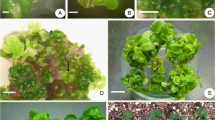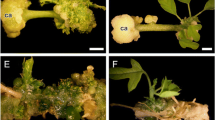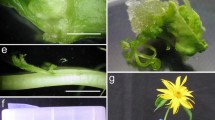Summary
Tennessee coneflower [Echinacea tennesseensis (Beadle) Small] was regenerated from flower stalks, leaf sections from flowering plants, and hypocotyls and cotyledons from seedlings. Murashige and Skoog medium (MS) supplemented with naphthaleneacetic acid (NAA) at 0.54 μM and thidiazuron (TDZ) at 22.7 μM yielded the most shoots per leaf explant. NAA and 6-benzylaminopurine concentrations for optimal shoot regeneration from leaf, flower stalk, cotyledon and hypocotyl explants in MS media were 0.54 and 24.6μM, respectively. All explant types generated shoots; however, those derived from leaves and flower stalks produced the highest number of shoots per explant and highest percentage of explants with shoots. Explants cultured on media containing high levels of NAA (5.4–27 μM) formed calluses but no adventitious shoot. Leaf explants responded to a wider range of NAA concentrations than the other explant types but shoots generated from flower stalks grew the fastest. While all cytokinins tested increased the number of shoots per explant, the number of shoots in media containing TDZ was increased by nearly threefold. Regenerated shoots from all explant types cultured on MS medium supplemented with 0.25 μM indole-3-butyric acid initiated roots within 4 wk; NAA was not effective for root induction. All vernalized plantlets developed into plants that were morphologically identical to the source material.
Similar content being viewed by others
References
Baskin, C. C.; Baskin, J. M. Propagation protocol for production of container Echinacea tennesseensis (Beadle) small plants In: Native Plant Network. Lexington: University of Kentucky; 2002 http://www.nativeplantnetwork.org.
Choffe, L. L.; Murch, S. J.; Saxena, P. K. Regeneration of Echinacea purpurea: induction of root organogenesis from hypocotyls and cotyledon explants. Plant Cell Tiss. Organ Cult. 62:227–234; 2000.
Drew, M. B.; Clebsch, E. E. C. Studies on the endangered Echinacea tennesseensis (Asteraceae): plant community and demographic analysis. Castanea 60:60–69; 1985.
Harbage, J. F. Micropropagation of Echinacea angustifolia, E. pallida, and E. purpurea from stem and seed explants. Hort Science 36:360–364; 2001.
Hemmerly, E. T. Life history strategy of the highly endemic cedar glade species Echinacea tennesseensis. Assoc. Southeastern Biol. Bull. 33:193–199; 1986.
Koroch, A.; Juliani, H. R.; Kapteyn, J.; Simon, J. E. In vitro regeneration of Echinacea purpurea from leaf explants. Plant Cell Tiss. Organ Cult. 69:79–83; 2002.
Lakshmanan, P.; Danesh, M.; Taji, A. Production of four commercially cultivated Echinacea species by different methods of in vitro regeneration. J. Hort. Sci. Biotechnol. 77:158–163; 2002.
Lineberger, D. Micropropagation for the perennial industry. In: Smith, E. M.: Still, S. M., eds. Proc. Herbaceous Perennial Symp., Columbus, OH. Ohio Coop. Ext. Ser. Bull. 717: 7–9; 1983.
McKeown, K. A. A review of taxonomy of the genus Echinacea. In Janick, J., ed. Perspectives on new crops and new uses. Alexandria, VA: ASHS Press; 1999:482–489.
Murashige, T.; Skoog, F. A revised medium for rapid growth and bioassays with tobacco tissue cultures. Physiol. Plant. 15:473–497; 1962.
Walck, J. L.; Hemmerly, T. E.; Hidayati, S. N. The endangered Tennessee purple coneflower, Echinacea tennesseensis (Asteraceae): its ecology and conservation. Native Plants J. 3:54–64; 2002.
Author information
Authors and Affiliations
Corresponding author
Rights and permissions
About this article
Cite this article
Sauve, R.J., Mmbaga, M.T. & Zhou, S. In vitro regeneration of the tennessee coneflower (Echinacea tennesseensis). In Vitro Cell.Dev.Biol.-Plant 40, 325–328 (2004). https://doi.org/10.1079/IVP2004530
Received:
Accepted:
Issue Date:
DOI: https://doi.org/10.1079/IVP2004530




